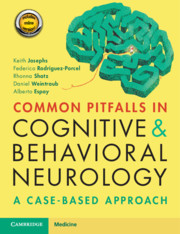Book contents
- Common Pitfalls in Cognitive and Behavioral Neurology
- Common Pitfalls in Cognitive and Behavioral Neurology
- Copyright page
- Dedication
- Contents
- Diseases Discussed in the Book
- Preface
- Acknowledgements
- Abbreviations
- Part 1 Missing the Diagnosis Altogether
- Part 2 Misidentifying the Impaired Cognitive Domain
- Part 3 Missing Important Clues in the History
- Part 4 Failure of Pattern Recognition
- Part 5 Difficult-to-Characterize Cognitive/Behavioral Disorders
- Part 6 Clinical Findings That Are Subtle
- Case 26 Something Does Not Look Right
- Case 27 Moving without Thinking
- Case 28 A Pause in the Clause
- Case 29 Seeing beyond Alzheimer Disease
- Case 30 “That Is Not How I Feel”
- Part 7 Misinterpreting Test Results
- Part 8 Attributing Findings to a Known or Suspected Disorder
- Part 9 Missing Radiographic Clues
- Part 10 Management Misadventures
- Index
- Plate Section (PDF Only)
- References
Case 26 - Something Does Not Look Right
from Part 6 - Clinical Findings That Are Subtle
Published online by Cambridge University Press: 03 November 2020
- Common Pitfalls in Cognitive and Behavioral Neurology
- Common Pitfalls in Cognitive and Behavioral Neurology
- Copyright page
- Dedication
- Contents
- Diseases Discussed in the Book
- Preface
- Acknowledgements
- Abbreviations
- Part 1 Missing the Diagnosis Altogether
- Part 2 Misidentifying the Impaired Cognitive Domain
- Part 3 Missing Important Clues in the History
- Part 4 Failure of Pattern Recognition
- Part 5 Difficult-to-Characterize Cognitive/Behavioral Disorders
- Part 6 Clinical Findings That Are Subtle
- Case 26 Something Does Not Look Right
- Case 27 Moving without Thinking
- Case 28 A Pause in the Clause
- Case 29 Seeing beyond Alzheimer Disease
- Case 30 “That Is Not How I Feel”
- Part 7 Misinterpreting Test Results
- Part 8 Attributing Findings to a Known or Suspected Disorder
- Part 9 Missing Radiographic Clues
- Part 10 Management Misadventures
- Index
- Plate Section (PDF Only)
- References
Summary
This 60-year-old woman presented with a 2-year history of cognitive changes and hallucinations concerning for dementia with Lewy bodies (DLB). She first reported seeing a bright moving circle out of her right visual field. The image was always the same and the episodes lasted 20 seconds. Their frequency increased to five times a day over the course of six months. After each episode, she experienced a headache lasting up to an hour with no associated nausea or photophobia. She had been initially diagnosed with migraine with aura and tried propranolol, verapamil and amitryptline, to no avail. Since starting topiramate six months prior to her evaluation the frequency had reduced to about once a day. However, she felt forgetful, slower in her thinking and had difficulty finding words since initiating topiramate treatment. The development of cognitive impairment in the background of hallucinations had raised the concern for early stages of DLB. However, she denied any motor changes (i.e., parkinsonism) or sleep disturbances (i.e., symptoms of REM sleep behavior disorder).
- Type
- Chapter
- Information
- Common Pitfalls in Cognitive and Behavioral NeurologyA Case-Based Approach, pp. 83 - 86Publisher: Cambridge University PressPrint publication year: 2020



